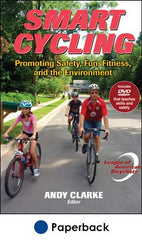Bicycling offers many benefits
This is an excerpt from Smart Cycling by League of American Bicyclists.
The bicycle is a simple two-wheeled machine that uses human power for propulsion. But riding this machine is one of the great and simple joys of life. It grants a sense of delight and accomplishment no matter your age or ability—from a 3-year-old on training wheels to an 85-year-old riding 50 miles in a day. The wind in your face and the freedom with which you flow over the earth can refresh the soul. Your heart pounds, and your muscles push you faster and faster up a hill. Then, as you stop pedaling and coast down the other side, a grin magically spreads across your face.
Of course, the benefits of bicycling include more than freedom and independence. Cycling helps you save money on fuel, get into better shape, and remain healthier longer. Bicycling is a fitness activity that the entire family can enjoy together. Bicycles are used for recreation, transportation, sport, and work. In fact, more people around the world use the bicycle as a means of transportation than any other vehicle (Did You Know? n.d.). Starting at below $100, the bicycle is a form of transportation virtually everyone can afford and a way of life that no one should pass up.
Lose Weight, Gain Fitness
The bicycle offers an enormous range of practical benefits for individuals, families, and society as a whole. Bicycling is one of the best activities for the cardiovascular system, and cycling is very effective for reducing weight and keeping it off. A 150-pound cyclist burns 410 calories in 1 hour while pedaling at a moderate pace of 12 miles per hour—burning the number of calories nearly equivalent to a plate of pasta with Alfredo sauce. A 200-pound cyclist burns 708 calories in 1 hour while pedaling at 12 miles an hour—burning calories equivalent to that of a lean steak with a baked potato and serving of broccoli (NutriStrategy 2005).
Get Mentally Healthy
Bicycling is good not only for the body but also for the mind. In addition to breathing fresh air and exercising, the cyclist is his own vehicle, using self-power instead of machine power to get from point A to point B. This is a remarkably good feeling—to ride by the bus parked in traffic, glide past the cars stopped on the road as you coast by on a trail, or arrive at work powered by nothing but your own legs. These achievements help frame each day as successful from the beginning. Bicycling also relaxes you, giving you time to think as you ride, reducing your stress levels, and increasing your self-esteem and self-confidence as you improve.
Bike to School
Bicycling remains a popular activity among children and a way to stay active and healthy for all ages, but it has declined as a functional mode of transport. According to the National Household Travel Survey, funded by the Federal Highway Administration, in the 1960s more than 40 percent of children bicycled and walked to school (sometimes "uphill both ways in the snow"!). Today, only 12 percent of children bike or walk to school. At the same time, a survey done by the Centers for Disease Control and Prevention (n.d.) shows children are fighting obesity and diseases at unprecedented rates. About 32 percent of American children and adolescents today—25 million kids—are obese or overweight, according to the survey, and diseases such as type 2 diabetes (known previously as adult-onset diabetes) and asthma are becoming more common. A return to biking to school could help combat some of these serious conditions and diseases. The national legislation creating the Safe Routes to School was passed in 2005 and allocated $612 million to programs that encourage children to walk and bike to school.
Start Your Day Right by Commuting
According to the 2009 Nationwide Personal Transportation Survey, 28 percent of all trips in the United States are a mile or less, and 40 percent of all trips are two miles or less. Though these distances can easily be traveled by bike, more than 72 percent of trips within three miles of home are made by personal motor vehicle. These statistics could radically change if more people chose to bicycle to work (figure 1.5).
People who commute to work by bike, rather than car, avoid stress-inducing traffic jams, tollbooth lines, and battles for parking spots. They arrive at work feeling energized instead of enervated. They are ready to work, not frustrated and in need of a break. Bicycle commuters often find they save time because they can breeze past traffic and do not need to hunt for a parking space for a vehicle. Generally, a bicycle commuter can easily find parking space for his bike. Bike commuters also get great exercise while cycling to work, saving the time and expense of health club workouts. In addition, bicycle commuters also save a small fortune in gasoline and automobile maintenance and repairs. In fact, many people who regularly commute by bicycle have found that their family can go from two cars to one, saving hundreds of dollars per month in auto and insurance payments. Some northern cities, including Minneapolis, Minnesota, and Madison, Wisconsin, are so good about plowing and keeping the trails and roads safe for cyclists that people ride year-round. That kind of dedication isn't necessary for everyone, though, and actually many cyclists don't have the equipment necessary to ride in a downpour or snow. However, it isn't necessary to bike in bad weather to enjoy the many benefits of commuting by bike.
More Excerpts From Smart Cycling

Get the latest insights with regular newsletters, plus periodic product information and special insider offers.
JOIN NOW


